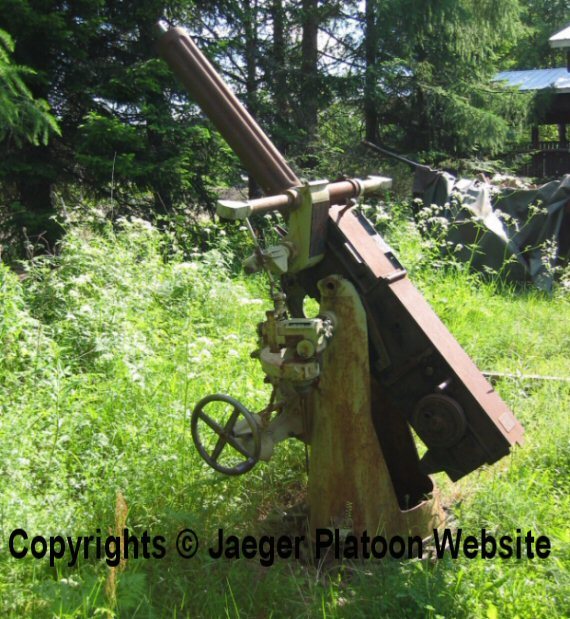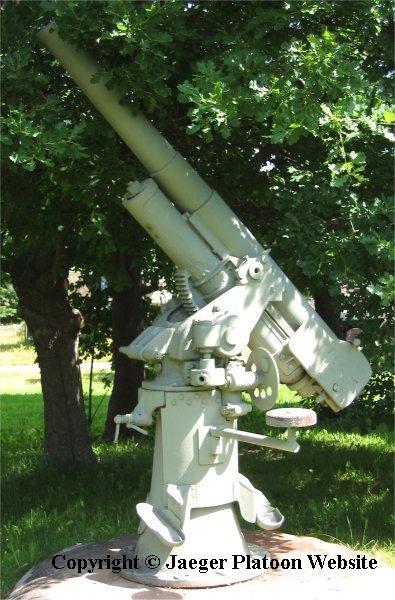First, an acknowledgement. All photos and OTL historically accurate details in this section on Finnish Army Anti-Aircraft Guns of the 1920’s are used courtesy of the Jaeger Platoon Website (Kiitos Jarkko) (http://www.jaegerplatoon.net/MAIN.html – this is a great website with a mountain of detailed information and photos on Finnish weapons – you name it, it’s there, however obscure) – and of course, any mistakes are mine.
Second, this post is intended to be a reasonably accurate coverage of Finnish Anti-Aircraft strength in the 1920’s, and not beyond, so guns purchased in the 1930’s (not that there were many OTL) are not covered. It’s strictly historical with a couple of minor ATL tweaks (guns on the Icebreakers is about the only deviation from the historical).
And now, …..Finnish Army Anti-Aircraft Guns of the 1920’s
WW1 had introduced aircraft to War, and anti-aircraft guns were already an established part of Military organizations in the early 1920’s. The Finnish Army was no exception but, as with Artillery, almost all AA Guns in service in the 1920’s was ex-WW1 equipment although some guns were bought through the 1920’s.
The development of methods for using antiaircraft artillery started within the Coastal Artillery. While the actual anti-aircraft artillery units once created belonged to the Army, the Coastal Artillery needed to defend its fortifications against aircraft. While it did not have enough suitable guns it did its best to develop methods, which allowed its existing guns to be also used for anti-aircraft fire. This development work for these dual-use guns was improvised as these guns most certainly had not been originally designed for antiaircraft use. Two coastal gun models were adapted to such use – the 75-mm Canet gun and the 152-mm Canet gun.
When it came to the 75-mm Canet only some gun mount versions used had enough elevation for anti-aircraft use and the most important of these was the Zenit-Meller version described below. The other gun, the 152-mm Canet coastal gun, was the largest calibre Finnish gun known to have succeeded in intentionally downing enemy aircraft during World War 2. And this was no accident – it was also the largest calibre gun used by the Finnish military for anti-aircraft fire. The 152-mm L/45 Canet coastal gun was originally introduced to Russian use in 1895. Due to Finnish improvements made to the 152-mm Canet coastal guns the elevation achieved with certain mount versions was high enough for anti-aircraft use and in their new Finnish-build positions they had a 360-degree firing sector.
At the same time the changes made by the Finnish military for these guns also increased their maximum rate of fire considerably. Even if their anti-aircraft fire was not terribly accurate their over 40-kg high-explosive shells equipped with time fuses packed such a punch that their fire was dangerous to any bomber formation which came within range of the time fuses used in their shells for this use. The anti-aircraft shooting method for these guns were developed in the early 1930’s and during World War 2 was in common use for those 152-mm Canet batteries, which had mounts giving their guns enough elevation for this kind of use. During WW2 these heavy coastal guns succeeded in downing several Soviet bombers and also at least one fighter aircraft.
And now, on to the guns……..
20 ItK/23, 20 mm antiaircraft-gun M/23 Semag-Oerlikon
Reinhold Becker, a German, had patented a 20-mm automatic cannon in 1913. During World War 1 the Germans tried introducing this as a Zeppelin weapon, but it proved too unreliable and was re-issued as an antiaircraft-gun in 1917. However, the unreliability of the Becker cannon continued in this antiaircraft-gun role as well. After WW1, a Swiss company called SEMAG (Seebach Maschnenfabric AG) became interested in the Becker cannon and bought the patents. SEMAG further developed the design and managed sell some guns, but didn’t manage to enjoy the fruits of this development before it went bankrupt in 1921.
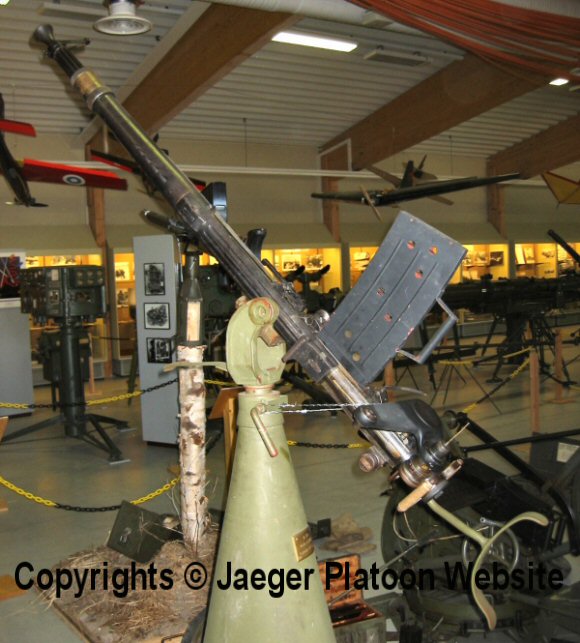 The SEMAG company was sold and changed name to Oerlikon AG in 1925. The Swiss themselves were first to adopt the gun for the use of their military in 1923 (hence the year-number in the Finnish name). The 20-mm Oerlikon guns were the most widely used 20-mm antiaircraft-guns before World War 2 and possibly also during it. They were exported to a large number of countries and at the same time license produced in the USA and Great Britain in huge numbers. The 20-mm Oerlikon gun was a large-scale commercial success before and during World War 2. Nowadays the company (now known as Oerlikon-Contraves) is one of the most well known developers and manufacturers of antiaircraft-guns.
The SEMAG company was sold and changed name to Oerlikon AG in 1925. The Swiss themselves were first to adopt the gun for the use of their military in 1923 (hence the year-number in the Finnish name). The 20-mm Oerlikon guns were the most widely used 20-mm antiaircraft-guns before World War 2 and possibly also during it. They were exported to a large number of countries and at the same time license produced in the USA and Great Britain in huge numbers. The 20-mm Oerlikon gun was a large-scale commercial success before and during World War 2. Nowadays the company (now known as Oerlikon-Contraves) is one of the most well known developers and manufacturers of antiaircraft-guns.
Finland was among first customers for these guns when it bought four from SEMAG in October of 1924. The guns were delivered to Finland in the summer of 1925. Early on the Finnish military found the guns problematic, but once the proper methods were developed their reliability proved satisfactory. However, so little ammunition was bought with the guns that almost all was spent in test firing. This later severely limited the amount of live firing during training. Mounts used with these four guns were the fixed M/24 (Swiss designation) column/cone mounts. After test firing, these guns (with very little ammunition) were given to Suojeluskunta units for training purposes.
37/30 Ma (37-mm Naval gun Maxim) (1-pound pom-pom):
This water-cooled and belt-fed automatic-gun was the real granddaddy of automatic-cannons and first gained popularity in the Boer War. In Britain the gun was well known as the 1-pound pom-pom gun. Tsarist Russia bought a small number of these guns from the Maxim-Nordenfelt factory in the 1890’s and during WW 1 the Russian Navy ordered 120 more from the Russian Obuhov factory. The Finnish company Ab H. Ahlberg & Co Oy also built about 60 of these guns during WW 1 and when the Civil War ended about half of these were still unfinished so they remained in Finland. The Finnish White Army captured total of 50 – 60 guns in the Civil War.
The mount for these guns was a column mount designed for naval use. It offered 360-degree traverse and about 70-degree elevation, so in theory these guns could be used as antiaircraft-guns. The Finns managed to get a bit over 30 of the captured guns into working order and they were used in warships and coastal artillery fortifications. The 37-mm Maxim automatic gun was never popular in Finnish use as it was unreliable and had quite a short range. The main reason for the short range was the 37 mm x 94R ammunition (with a moderate muzzle velocity of only about 440 m/sec), which didn’t really have the ballistics needed for proper antiaircraft-use. As if this would not have been enough, the reliability of old fuses used in their high explosive shells also proved questionable.
OTL: During WW2 some of these guns were in coastal forts, where their unsuitability for anti-aircraft use became painfully obvious. However they were not totally useless – the guns proved somewhat reliable when fired with only a low elevation. This was likely because shooting with low elevation didn’t stress their fabric ammunition belts quite as much as shooting with higher elevation. In either case, Finnish coastal defence decided to use them mainly as close range defence weapons of its coastal forts against surface targets and these old guns proved somewhat successful in this role. Still, since the coastal forts had a rather limited amount of anti-aircraft weaponry at best, sometimes these guns were also fired against enemy aircraft. At least once this produced results – the Humaljoki Coastal Battery downed a Soviet bomber with a 37-mm Maxim automatic gun on the 25th of December 1939. Anyway, by the end of World War 2 they were terribly outdated and the last remaining 16 guns were ordered to be scrapped soon after the Continuation War ended in 1944.
ATL: Unchanged
40 ItK/34 V (40 mm AA-Gun model 1934 Vickers) aka 40/40 V34 (40-mm Naval gun model 1934 Vickers): (2-pound pom-pom)
This belt-fed 40-mm automatic was manufactured under license by Vickers. In Britain it was more commonly known as the 2-pound pom-pom gun. The gun was based on the older 1-pound (37-mm) version, and was basically an enlarged version of the Maxim machinegun.
The subsidiary company of Vickers in Italy was Vickers-Terni, which introduced the 40-mm version in 1915. Besides calibre and size these automatic guns had very similar characteristics to Maxim machineguns. Unfortunately these shared characteristics also included unreliability and short range (caused by the weak ballistics of 40 mm x 158 R ammunition). The unreliability was also partly due to the fabric ammunition belts used in them. After WW1, the development of the 40-mm Vickers automatic gun continued and they saw large scale use with the British Navy during World War 2.
During WW1, the Russian Army and Air Force ordered the guns, which were also used in ships of the Russian Navy. The Finns captured a few in the Civil War. The Finnish military had two names for these guns – 40 ItK/15 V (40 mm antiaircraft gun model 1915 Vickers) and 40/40 V15 (40-mm Naval gun model 1915 Vickers). During WW2 the Finnish military had four of these captured guns, for which Crichton-Vulcan had manufactured new column mounts in 1934. Vickers had continued to further develop the guns and was selling them actively in the 1920’s and 1930’s. In 1932 the Finnish Navy bought eight of these improved guns. They were called the 40 ItK/34 V (40 mm antiaircraft gun model 1934 Vickers) and 40/40 V34 (40-mm Naval gun mtodel 1934 Vickers).
ATL, the new 40/40 V34 guns were installed in the then brand new Finnish icebreakers which were being built. The guns proved as poor in wartime use as the peacetime experiences had already earlier suggested. So after the Winter War the guns were replaced with 40-mm Bofors and the 20mm Vickers were then used in coastal fortifications where they were mostly intended to be used used against surface targets, but occasionally they also were used as antiaircraft-guns.
75 mm Zenit-Meller.
The Tsarist Russian Navy had adopted the 75-mm Canet gun for use in 1891. During WW1 antiaircraft guns were needed and the Russians considered the 75-mm Canet guns basically suitable as a fixed anti-aircraft gun. However, the existing mounts didn’t give enough elevation, so a new Meller-mount (named after its developer, a Captain Meller) was designed for antiaircraft-use. The first guns with the Meller mount were delivered in the autumn – winter of 1914. In Russia/Soviet Union, the 75-mm Zenit-Meller antiaircraft-guns were manufactured until the late 1920’s and presumably some were still used in WW2.
The Finns captured a few of these guns in the Civil War of 1918 and the unofficial starting point of antiaircraft artillery practices in Finnish Armed forces originated with Captain Åke Törnroos of the Finnish Coastal Artillery taking command of the coastal fort on Kuivasaari Island outside Helsinki. On Kuivasaari Island he noticed two 75-mm Zenit-Meller coastal guns that the Russians had left behind in 1918 and he got interested about them. The Finnish military knew that the guns had been intended for shooting at Zeppelins and aircraft, but not much else. At that time the Finnish military didn’t yet have antiaircraft weapons or methods for shooting at air targets. This got Captain Törnroos excited: the idea of having two weapons but no information on how to use them simply didn’t suit him.
Törnroos started gathering information from all possible sources. Combining the information with his mathematical skills he developed the first rudimentary methods for shooting at air targets and tested it with the guns. He soon got support from Väinö Valve, who was Commander of Coastal Artillery at that time. This was the starting point for developing antiaircraft-weaponry and methods for shooting at air targets in the Finnish Coastal Artillery and later led to the establishing of the first Finnish antiaircraft-artillery units. In the 1920’s the Finnish Coastal Artillery had 18 of these guns and the Navy had 10. The guns saw some use against air targets also during WW2, but their main influence on history was to be the weapons which started of the development of antiaircraft-warfare techniques in Finland.
76 ItK/14, Putilov (76 mm antiaircraft gun M/14 Putilov)
The first guns the Russians had used as antiaircraft-guns during World War 2 had been 76-mm model 1902 field guns installed on AA-platform, the platforms were fixed wooden structures on top of which the whole field gun was placed. The mounts allowed circling around the central point giving the gun a 360-degree traverse and a higher elevation adjustable with the field guns own elevation adjustment system. The system was rudimentary and had little chance of hitting anything but a slow moving Zeppelin or fixed observation balloon, so better anti-aircraft guns were desperately needed. During WW1 the French had developed an anti-aircraft gun version from their 75-mm model 1897 field gun, and this gave the Russians the idea for developing a similar kind of weapon.
In other words: this gun, the model 1914 Putilov, which was basically the Russian 76-mm field gun m/1902 barrel equipped with a half-automatic breech with sliding breechblock and installed on top of a column mount suitable for antiaircraft-use. Even the ammunition of this gun used the same cartridge cases as the Russian/Soviet field guns of this calibre. The designers of the gun were Captain V.V. Ternovskij and Engineer F. F. Lender, after whom the Soviets later named these guns “Lender’s guns”. They were manufactured in the Putilov Artillery Factory (later renamed the Kirov Artillery Factory by the Soviets) starting in March of 1915. However the Russians also soon developed an improved version that same year. The official Russian/Soviet name for the gun was 8-K. They installed it in fixed gun positions, on ships, horse-drawn carts, on top of trucks and also on the railway cars of armoured trains. The Soviets also modernised their 8-K guns in the 1920’s and were still using them during World War 2.
The Finnish White Army captured 2 guns used on a Red armoured artillery wagon of the armoured train named Ukrainski Revolutsija (Revolution of the Ukraine) during the Finnish Civil War. After 1918 the armoured artillery railway wagon equipped with them had been dismantled and the guns had been forgotten in the Fredriksberg Engineering Works. On the 26th of July 1926 they were found there and become the first AA-guns issued to the first Finnish AA-artillery unit, which had been established on the 18th of June 1926. The ammunition used in these was the same as in the 76 K 02 field guns, so there was very little problem in getting ammunition for them. During the Winter War they were used as AA-guns with an improved aiming system and in 1945 they were finally warehoused for possible further use, which never came. The two guns now belong to the collection of the Anti-aircraft Museum.
The Bofors 76 mm antiaircraft gun series
In typical WW1-era fashion Bofors started its production of anti-aircraft guns by modifying an existing Swedish 75-mm naval gun to anti-aircraft use in 1914. After this the company modified more 75-mm naval guns suitable for anti-aircraft use for Norway starting in 1915. This was followed by a deal to manufacture some earlier ordered but not delivered Krupp-designed anti-aircraft guns for the Netherlands in 1919. Still, in the mid 1920’s Bofors had no heavy anti-aircraft gun design of its own. In 1926 things started to change, when orders for test-guns arrived from the Swedish Royal Ordnance Administration and Netherlands. However the biggest heavy AA-gun order for that year was a Finnish order of eight 76.2-mm anti-aircraft guns.
Of these 8 guns, 4 were to be fixed guns (later named 76 ItK/27 BK) and other four were to be mobile guns (later named 76 ItK/28 B), which could be towed. All the eight guns were rather traditional and obviously based on earlier Krupp designs. However as these small production runs could well be considered a test-series of sort, both gun models had some notable differences. Later Finland ordered a second patch of four 76 ItK/27 BK’s and an additional four mobile (towed) 76 ItK/29 B’s. The first purpose-build Bofors-designed heavy AA-gun was the 75-mm anti-aircraft gun m/30, which was a further development based on guns bought in small numbers by China, Finland, Hungary and Persia in late 1920’s.
The 76 ItK/27BK: (76 mm antiaircraft gun M/27 Bofors, fixed version)
This gun was a fixed version of the heavy Bofors anti-aircraft gun, which had a column mount bolted to a concrete structures in a ready fire-position. The breech mechanism of the gun was the typical semi-automatic (after firing the gun the breech would automatically remove cartridge case and stay open for loading of the next shell) vertical sliding block breech.
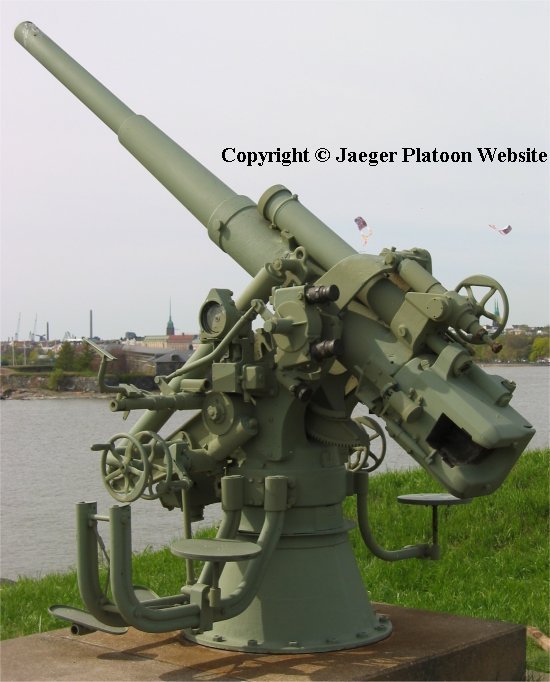
76-mm Bofors M/27 fixed anti-aircraft gun. Many of the instruments are missing. Photo taken in middle of kite-flying competition, so there are two on the background. (Photo taken in Suomenlinna).
The guns were also equipped with equipment for setting correct fuse settings fast. A well trained crew could achieve a rate-of-fire as high as 25 shots/minute for a short time, but long-term rate of rate-of-fire was only about 12 – 15 shots/minute. Both buffer and recuperator of the recoil system were located above barrel. Finland bought eight of these guns from Bofors. The first four were ordered in December of 1926 and arrived December of 1927. The other four guns were ordered in June of 1928 arrived in September of 1929. During the Winter War (and OTL Continuation War) the guns were used with the Vickers M/34 (subversion Vb) mechanical fire-control computer and were located as part of the air-defence of Helsinki. The 76-mm Bofors AA-guns proved very effective and remained in use until the end of World War 2.
During World War 2 the ammunition chosen for these guns caused additional problems with regards to their ammunition supply. The cartridge cases used for them were unique – in other words not used in any other guns or any other country anywhere. As the number of these cartridge cases had been rather limited to begin with, once used they needed to be sent for reloading without delay.
76 ItK/28 B, Bofors (76 mm antiaircraft gun M/28 Bofors, mobile version)
These guns were the 76.2-mm mobile antiaircraft-guns Bofors Ab manufactured for Finland. Just like the fixed 76 ItK/27 BK and 76 ItK/29 B they belonged to a number of small production series Bofors manufactured for China, Greece, Hungary and Persia in the late 1920’s.
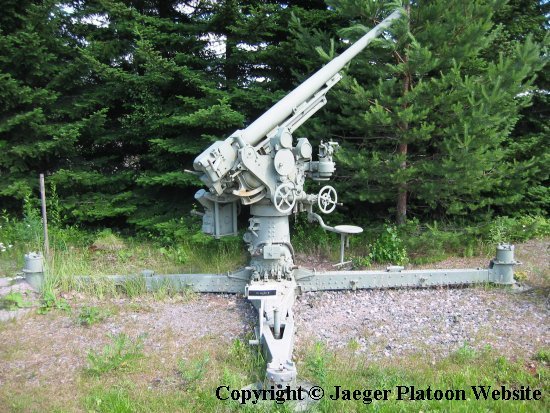
76-mm Bofors M/28 AA-gun. Again many of the instruments are missing. (Photo taken in Ilmatorjuntamuseo).
Finland ordered 4 of these guns in December of 1926 (at the same time as the four 76 ItK/27 BK), but they were not delivered until December of 1928. They were the first mobile heavy anti-aircraft guns in Finnish use. For transporting them a heavy one axle, two wheeled driving device was used. The mount type used is a column mount with four legs (cruciform-mount) typical of mobile anti-aircraft guns of that time. The gun was semi-automatic (after firing a shot, it removed the cartridge case and remained open for reloading) horizontal sliding wedge breech. In the recoil systems of these guns, both buffer and recuperator were located below the barrel.
In 1931 these four guns were transferred to the Helsinki Suojeluskunta (Civil Guard), which used them to train anti-aircraft gun crews before the Winter War. During Winter War (and OTL, the Continuation War) they were used on the home front with Vickers M/34 (subversion Va) mechanical fire control computers. These guns proved very effective and remained in use until end of World War 2.
76 ItK/29 B, Bofors (76 mm antiaircraft gun M/29 Bofors, mobile version)
Just like the 76 ItK/27 BK and 76 ItK/28 B, Bofors Ab manufactured also these guns by for Finland. All the three gun models can be considered as part of the test-series manufactured by Bofors in late 1920’s. Finland bought 4 of these guns and they were delivered in November of 1929. For transporting the guns a heavy one axle and two wheeled driving device was used.
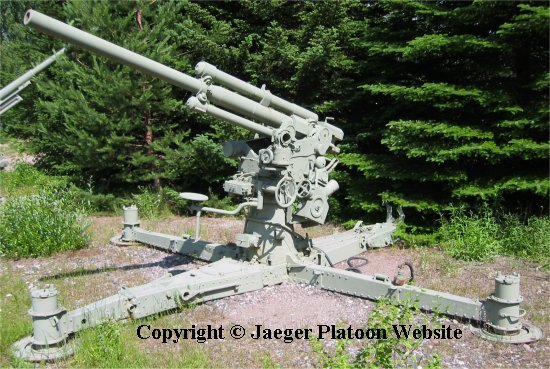
76-mm Bofors M/29 AA-gun. As usual many of the instruments are missing. (Photo taken in Ilmatorjuntamuseo).
The mount type used is column mount with four legs typical (cruciform mount) to mobile anti-aircraft guns of that time. The gun also has semi-automatic horizontal sliding wedge breech (which after firing the shot removed used cartridge case and remained open for reloading). In the ecoil system of these guns the buffer was located below the barrel and the recuperator above it. During Winter War and Continuation War the guns were used with the Vickers M/34 (subversion Vc) mechanical fire control computers. They proved very effective and remained in use until end of World War 2. These guns used exactly the same ammunition as the 76 ItK/28 B and 76 ItK/34 V.
Afterword – Finnish Army Anti-Aircraft Guns
OTL, prior to the Winter War, Finland took delivery of 53 x Bofors 40mm AA Guns in 1939 as well as a small number of Madsen 20mm AA Guns, 30 x German Flak-30’s (just before the Winter War) and a small number of Lahti-designed 20 mm L-34 AA guns which were fitted to Finnish Coast Guard boats in the 1930’s. And in the Original Time Line, that was the AA strength of the Finnish Army when the Winter War started.
In this Alternative Time Line, Finnish Anti-Aircraft Guns will proceed a little differently in the 1930’s.
 Copyright secured by Digiprove © 2013 Alternative Finland
Copyright secured by Digiprove © 2013 Alternative Finland


